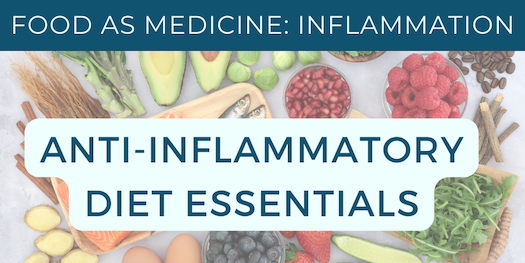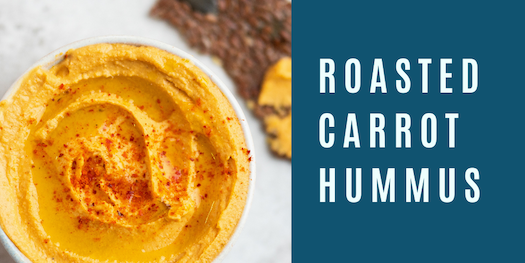Inflammation is one of the top buzzwords for 2023.
And for a good reason. While I have no intention of fear-mongering you about inflammation, I want to EDUCATE and EMPOWER you to live and feel better.
The fact is, food plays a crucial role in how you feel and perform in life. Short-term inflammation is associated with brain fog, fatigue, and achy joints. In contrast, long-term inflammation is linked with chronic diseases such as cancers, diabetes, heart disease, depression, etc.
The good news is that your food and lifestyle habits can combat inflammation. And reducing your body’s inflammation leaves you feeling healthy, strong, and ready to embrace the day!
I hope you enjoy this issue as I dive into the essentials of an anti-inflammatory diet. If you’re ready to go deeper in fighting inflammation to nourish a healthier and stronger life, contact me for a private session!
-Stephanie
|
|
|
The Essentials of an Anti-Inflammatory Diet
|

Vegetables and Fruits: Study after study continues to show that a high intake of vegetables and fruits offers significant protein against cancer, heart disease, and other chronic diseases. Low in calories and rich in antioxidants, vitamins, minerals, and phytochemicals, vegetables and fruits are the cornerstones of an anti-inflammatory diet. Eating a variety of produce, from leafy greens to carrots to berries, provides the nutrients essential for a vibrant and strong life.
How to Eat It: Create the habit of including a vegetable or fruit at every meal and snack! The more you practice adding produce to your meals, the easier it will become, and the better you will feel!
Pro Tip: Fresh and frozen produce provide more health benefits than canned or dried versions.
The Right Fats: Monounsaturated fats, such as extra-virgin oil and avocado oil, are high in oleic acid and polyphenols, providing significant anti-inflammatory properties.Omega-3 fatty acids are essential for regulating the production of pro and anti-inflammatory compounds.
How to Eat: Use Extra Virgin Olive Oil as your primary fat in food preparation, including as salad dressing. Fatty fish such as sardines, mackerel, and wild salmon are the best sources of omega-3 fatty acids rich in EPA and DHA.
Pro Tip: Eat fish 2 to 3 times a week to help keep inflammation in check. Supplement with fish oil.
Whole Grains: Whole grains are rich in fiber, antioxidants, and phytochemicals, helping to reduce cholesterol levels, promote digestive health, and reduce chronic inflammation. Grains such as brown rice, barley, quinoa, millet, and wheat berries support a healthy gut microbiome, helping to reduce inflammation.
How to Eat It: Step up your whole-grain game and experiment in the kitchen with barely, millet, and wheat berries! Include cooked barely-in green salad for a nutrient-dense energy boost, top baked goods with raw millet for an extra crunch, and add cooked wheat berries to soups.
Pro Tip: Cooked grains such as rice, barley, or quinoa can be frozen and reheated for leftovers.
Plant-Based Proteins: Vegetable proteins such as beans, legumes, nuts, and seeds are high in fiber, magnesium, and phytonutrients. Studies have shown magnesium can help reduce inflammation—vegetable protein beneficial phytonutrients.
How to Eat It: Add to salads, soups, or as a side dish.
Pro Tip: You can add white or cannellini beans to a smoothie. Just ¼ cup gets you all the benefits, including added protein and fiber, and you won’t taste them. That’s a win-win!
|
|
|
The Anti-Inflammatory Lifestyle Checklist
|

Drink More:
Move More:
- Aim for at least four days a week of exercise
- Incorporate strength and flexibility exercises into your routine
- Include movement that increases your heart rate for cardiovascular health
- Add more steps in your day-to-day activities
Enjoy in Moderation:
- Plain dark chocolate(with a minimum cocoa content of 70 percent).
Eat Less:
- Sugar
- Fried foods
- Red meat
- Refined carbohydrates such as white bread, pastries, and cookies
Dink Less:
- Alcohol - If you drink, limit to no more than one drink per day for women or two drinks per day for men
- Sweetened beverages, including sodas and sports drinks
Don’t:
Do Explore:
- Adding a supplement regime to help reduce inflammation. Schedule a consult to learn more!
|
|
Featured Recipe
Roasted Carrot Hummus
|

Recipe by Wasa
- 4 - medium carrots (washed, ends trimmed)
- 1 - small white onion (cut in chunks)
- 1 - clove garlic (peeled)
- 1 pound - uncooked red lentils
- 1 tablespoon olive oil
- 1 teaspoon curry powder
- 1 tablespoon lemon juice
- ½ teaspoon chili powder
- ½ teaspoon black pepper
- 1 tablespoon tahini (optional)
- ½ pound walnuts
- ½ teaspoon ground cumin
- Water to thin
- Fresh cilantro or parsley (for extra fanciness)
How to:
- Heat the oven to 200 degrees.
- Add the onion chunks, garlic cloves, and carrots on the baking tray.
- Drizzle over with rapeseed oil, salt curry powder, and cumin powder.
- Roast the vegetables for 20 minutes or until soft.
- Boil the lentils according to the packaging instructions.
- In a pan heated to medium heat, add the walnuts, toast for five minutes, and stir continuously to prevent burning.
- Now it’s time to combine everything! Add the roasted vegetables, the boiled (and drained) lentils, lemon juice, chili powder, black pepper, tahini and water in a food processor.
- Process until smooth. Scrape down the sides if needed.
- Taste and add more salt or other spice if needed.
- Add the toasted walnuts and pulse a few times (you want the walnuts to be roughly chopped to give the hummus some texture.
- Serve it on a Wasa crisp bread!
|
|
|
Be Inspired
|
|

|
|
|
About SO Nutrition
|
 Stephanie Leipprandt Ouellette, MBA, RDN, LD
Stephanie Leipprandt Ouellette, MBA, RDN, LD Stephanie has been working in the field of nutrition and dietetics since 1995. She earned a Bachelor of Science degree in Dietetics from Michigan State University, completed an Approved Pre-Professional Practice Program at Western Michigan University and earned a Master of Business Administration from Baker College. She’s been a Registered Dietitian Nutritionist since 1996 and licensed in Texas since 2007. In 2008, Stephanie earned her certification in Childhood and Adolescent Weight Management. Stephanie has extensive clinical & managerial experience, both in corporate settings and in the community. Now she wants to share her knowledge with you, because most (if not all) nutritional habits begin at home.
Stephanie and her family reside in Katy, Texas
|
|
| |
Copyright © 2023 Customized Nutrition Newsletters, All rights reserved.
|
|
| |
|
|